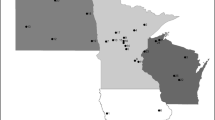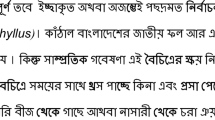Abstract
We have been selecting high yielding American hazelnut (Corylus americana) from wild populations. Because hazelnuts tend to have a spreading growth form, it was unclear whether phenotypic variation among the individual stems of a clump was due to multiple genotypes which had grown together. This would significantly complicate selection. In order to determine if these bushes were single genotypes, we collected leaf samples from the four cardinal directions from each of 23 high producing stems. These were analyzed for 4–6 microsatellite loci. We determined that of the 23 selections, 5 were composed of more than one genotype. Additionally, one clump had one allele on one direction that was different (likely allele dropout from a heterozygote where one allele did not amplify correctly). Overall, the majority of clumps (78 %) were composed of a single genotype. This suggests that selecting at the level of “clump” is viable. Additionally, we noticed that within our selection sites, certain plants seemed to function only as males (produced male catkins but seldom produced female flowers) while others produced copious female flowers and subsequently nuts. Within one site, we selected 20 hazelnuts with both male and female flowers and 19 with only male flowers. Using the same microsatellite techniques for 10 loci, we assessed whether there were obvious genetic differences between these types of plants. Overall, there was no difference between plants that bore female flowers and those that did not. Microsatellite DNA techniques are becoming a more useful tool for selection of potential agroforestry crops from wild populations.
Similar content being viewed by others
References
Bassil NV, Botta R, Mehlenbacher SA (2005) Microsatellite markers in hazelnut: isolation, characterization, and cross-species amplification. J Am Soc Hortic Sci 130(4):543–549
Bertin RI (1982) The ecology of sex expression in red buckeye. Ecology 63(2):445–456
Boccacci P, Akkak A, Bassil NV, Mehlenbacher SA, Botta R (2005) Characterization and evaluation of microsatellite loci in European hazelnut (Corylus avellana L.) and their transferability to other Corylus species. Mol Ecolo Notes 5:934–937
Carsey KS, Tomback DF (1994) Growth form distribution and genetic relationships in tree clusters of Pinus flexilis, a bird-dispersed pine. Oecologia 98(3/4):402–411
Demchik MD, Fischbach J, Kern A, Lane J, McCown B, Zeldin E, Turnquist K (2014) Selection of American hazelnut as a potential oilseed crop. Agrofor Syst 88:449–459
Elmeer K, Mattat I (2012) Marker-assisted sex differentiation in date palm using single sequence repeats. 3 Biotech 2:241–247
Fischbach J, Demchik M, Brasseur K (2010) Screening wild populations of American hazelnut in NW Wisconsin for high yielding plants. Bayfield County UW-Extension Research Bulletin #16, Washburn, WI
Franklin DC, Kaneko S, Yamasaki N, Isagi Y (2008) Short communication. Some wild bamboo clumps contain more than one genet. Aust J Bot 56:433–436
Gurcan K, Mehlenbacher SA, Botta R, Boccacci P (2010) Development, characterization and mapping of microsatellite markers for European hazelnut (Corylus avellana L.) from enriched genomic libraries and usefulness in genetic diversity studies. Tree Genet Genomes 6:513–531
Hazelnut and Products Exporters’ Association (2010). Turkish Hazelnut Export. http://www.ieuhazelnut.org/turkish-hazelnut-export.asp. Accessed 17 Dec 2010
Inouye RS, Allison TD, Johnson NC (1994) Old field succession on a Minnesota sand plain: effects of deer and other factors on invasion by trees. Bull Torrey Botan Club 121(3):266–276
Liu K, Muse SV (2005) PowerMarker: integrated analysis environment for genetic marker data. Bioinformatics 21:2128–2129
Lloyd DG, Webb CJ, Primack RD (1980) Sexual strategies in plants. II. Data on the temporal regulation of maternal investment. New Phytol 86(1):81–92
Peakall R, Smouse PE (2012) GenAlEx 6.5: genetic analysis in Excel. Population genetic software for teaching and research—an update. Bioinformatics 28:2537–2539
Rutter M (1991) Variation in resistance to eastern filbert blight in hybrid hazels. North Nutgrow Assoc Proc 82:159–162
Sato T (2002) Phenology of sex expression and gender variation in a heterodichogamous maple Acer japonicum. Ecology 83(5):1226–1238
Torick L, Tomaback DF, Espinoza R (1996) Occurrence of multi-genet tree clusters in “wind-dispersed” pines. Am Midl Nat 136(2):262–266
Vander Wall SB (2001) The evolutionary ecology of nut dispersal. Bot Rev 67:74–117
Weschke C (1954) Growing nuts in the North. Webb Publishing Co, St. Paul
Acknowledgments
This project was funded in part by the University of Wisconsin Stevens Point University Professional Development Committee and the Wisconsin Institute for Sustainable Technology. Numerous students were involved in the collection and processing of these samples: some include Kevin Schwartz, Helana Nelson, Emily and Benjamin Demchik, and others. Sophie Demchik and two anonymous reviewers provided review of the paper. Various state and federal land managers provided site access.
Author information
Authors and Affiliations
Corresponding author
Rights and permissions
About this article
Cite this article
Demchik, M., Fischbach, J., Kern, A. et al. Using microsatellite DNA to determine whether American Hazelnut Clumps are multiclonal. Agroforest Syst 90, 927–931 (2016). https://doi.org/10.1007/s10457-016-9902-6
Received:
Accepted:
Published:
Issue Date:
DOI: https://doi.org/10.1007/s10457-016-9902-6




